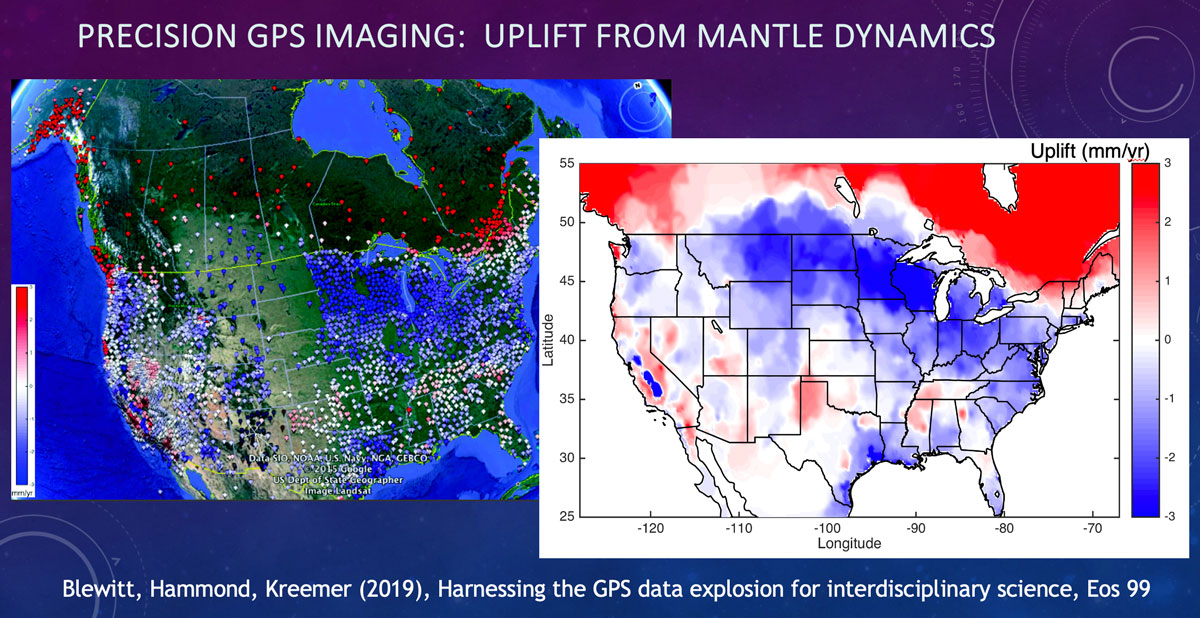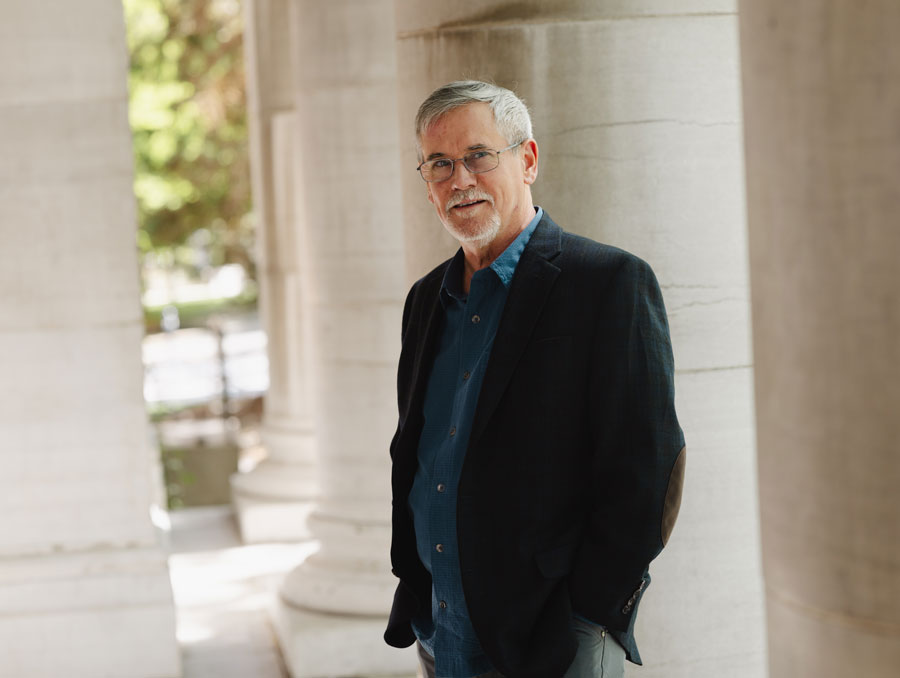Geoffrey Blewitt, University of Nevada, Reno Professor in the Nevada Bureau of Mines and Geology, founding member of the Nevada Geodetic Laboratory and one of the leading scientists credited with making the Global Positioning System (GPS) a tool precise within a millimeter, was elected to the National Academy of Sciences on Tuesday, April 30, 2024. Election to the academy is one of the highest honors a scientist can achieve. Many National Academy of Sciences members go on to win Nobel Prizes.
“It's quite an honor,” Blewitt said. “And it most importantly comes from the people who are already members. It was not something I expected at all – I thought it was way out of my league.”
Blewitt’s humble response is framed by a career of profound impact. Among many discoveries and technological advancements, Blewitt was one of the first scientists to pursue more precise GPS data, helping to transform the technology into the revolutionary tool it is today.
“GPS wasn't really designed to be a high-precision tool,” Blewitt said. “It was really designed to position objects within the size of a room. Now when we talk about positions, we talk about accuracy within a millimeter anywhere on the globe.”
"I wish people understood how important the field of geodesy is. [...] The Department of Defense depends on it. Global infrastructure depends on it. There is going to be geodesy on the Moon and on Mars. Things just work because there are people in my field making sure things continue to work.”
Blewitt’s work has contributed to other improvements in GPS and satellite technologies, and he is the co-inventor of three software patents including two from NASA projects. At the University of Nevada, Reno, he founded the Nevada Geodetic Laboratory which collects, processes and makes publicly accessible GPS data collected from around the world. He started the lab at the University over 20 years ago with colleagues in the Nevada Bureau of Mines and Geology, Professors Corné Kreemer and Bill Hammond.
“It's a tremendous amount of data,” Blewitt said. “We process all of the data in the world that's ever been made available since the GPS system became operational in 1994 and make it freely available.”
The data is sourced from over 22,000 GPS stations around the world, each producing data from 30 satellites every 15 or 30 seconds. Scientists are using this data to better understand everything from the shifting of tectonic plates to sea-level rise and changes in water vapor in the atmosphere. The data has become a cornerstone of recent atmospheric science research, often serving as a way to check the accuracy of climate models. As a result, Blewitt’s inbox is flooded with alerts for new research citations.
“It's kind of off the charts, it's hard to keep track of,” Blewitt said. “In my inbox every day, there may be several papers that have come out that day that cite our data.”
From big data to dark matter
Blewitt puts the data to work himself as well. His publications have been cited nearly 18,000 times with over 6000 citations since 2019. He’s using the GPS data the Nevada Geodetic Lab is collecting in novel ways and his discoveries include revealing the lifting of the Sierra Nevada Mountain Range and sinking of the valleys in California due to groundwater depletion, the impacts on moisture in the atmosphere due to climate change and showing how the Earth’s shape is warping as the ice sheets in Greenland melt. More recently, Blewitt has returned to his roots in physics and is using GPS to better understand dark matter.

At the 23rd International Union of Geodesy and Geophysics (IUGG) General Assembly in Berlin, Germany, Geoffrey Blewitt presented on geodesy and its role in better understanding the Earth. The slide from that presentation pictured here shows a map of the U.S. color-coated to represent areas where the land is either sinking or lifting due to the removal of groundwater, drought or other geophysical influences. An especially striking contrast can be seen in California where the Sierra Nevada Mountains are sharply lifting while the valleys sink lower as groundwater is pumped from the region. Blewitt describes being surprised by this discovery when analyzing the GPS data: "The pumping of water, of course, makes the ground go down in the valleys of California. But what we didn't expect was that it also reduces the weight on the Earth's surface and is causing the Sierra Nevada Mountains to rise up. We caught that pattern in the data."
“We don't have a clue what dark matter is, but we know it's out there,” Blewitt said. “We’re looking at theories that predict dark matter affects atomic clocks. We’re looking for evidence in the atomic clocks in the satellites of the GPS system.”
This return to fundamental physics and the discovery of dark matter is what could earn Blewitt the Nobel Prize, though he’d be too modest to admit it.
“My colleague Andrei Derevianko (University of Nevada, Reno Professor of Physics) and I are looking in as many places as we can, but nature does not always reveal itself,” Blewitt said. “One thing we have to be careful about is that we don’t get tricked by what we’re looking at. I'm always the most skeptical person when I'm looking at data.”
“That’s where discoveries are being made – at the boundaries.”
Blewitt’s career is marked by interdisciplinary work and, as he describes, the freedom to pursue novel research topics at the University of Nevada, Reno. He describes his work with students and faculty across campus as “tearing down the walls between departments.” Blewitt pursues scientific discovery with agility. He harnesses the analytical instincts of the engineer to make systems work and the mindset of the physicist to apply the scientific method and theoretical thinking to the unanswered questions about the universe. He describes his biggest discoveries as being made “at the boundaries” of several fields. Being elected to the National Academy of Sciences is indicative of Blewitt’s impact across several fields and far beyond.
“I was thrilled to learn of Geoff’s nomination to the National Academy of Sciences,” Executive Vice President and Provost Jeff Thompson said. “I was thrilled, but not at all surprised. Geoff is an international leader in the field of geodesy, known by his first name. I am honored to have him listed among our faculty and am humbled to consider him a friend.”
Blewitt hopes his nomination to the National Academy of Sciences will bring awareness to the field of geodesy. Because the field is so fundamental to how we live our day-to-day lives, Blewitt laments, it is often overlooked.
“I wish people understood how important the field of geodesy is,” Blewitt said. “You might be able to imagine GPS systems – what would the world be like if we suddenly switched that off? We would be in quite a bit of trouble, you can imagine. The Department of Defense depends on it. Global infrastructure depends on it. There is going to be geodesy on the Moon and on Mars. Things just work because there are people in my field making sure things continue to work.”
In addition to his research and directing the Nevada Geodetic Laboratory, Blewitt continues to teach both graduate and undergraduate students, passing on his wealth of knowledge and passion for the field to the next generation of scientists who will keep the world running smoothly.
About the National Academy of Sciences
The National Academy of Sciences is a private, non-profit society of distinguished scholars. Established by an Act of Congress, signed by President Abraham Lincoln in 1863, the National Academy of Sciences is charged with providing independent, objective advice to the nation on matters related to science and technology. Scientists are elected by their peers to membership in the National Academy of Sciences for outstanding contributions to research. The National Academy of Sciences is committed to furthering science in America, and its members are active contributors to the international scientific community. Approximately 500 current and deceased members of the National Academy of Sciences have won Nobel Prizes, and the Proceedings of the National Academy of Sciences, founded in 1914, is today one of the premier international journals publishing the results of original research.
Blewitt now joins this elite cohort of scientists.
“I would challenge anyone to consider a world without the precisely accurate GPS we are accustomed to today. Imagine just a few hours without that tool, and you can understand its significance in our world,” University President Brian Sandoval said. “Dr. Blewitt’s contributions to the precision of the GPS tools we use daily, natural resource exploration, global positioning science and now to the field of climate science and physics cannot be overstated. This recognition by the National Academy of Sciences is well deserved.”
Blewitt is one of two Nevada System of Higher Education faculty members elected to the National Academy of Sciences, the first being Professor of Anthropology Catherine S. Fowler in 2011.
















